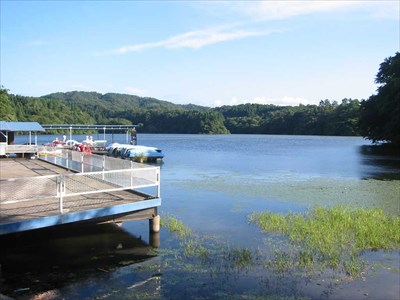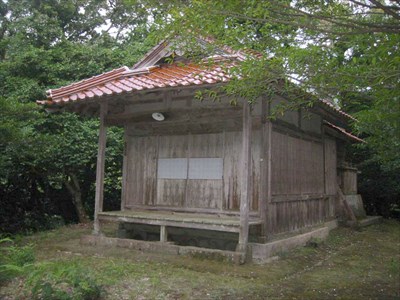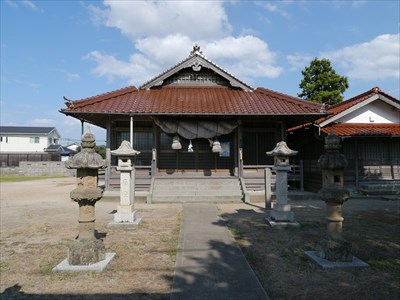| Home>Legend>Article |
Ukinuno Pond and Himenoga Pond
The following text is a slightly modified machine translation and may have some unnatural parts.
==Introduction==
There are a few ponds scattered at the foot of Mt. Sanbe in Oda City, Shimane Prefecture.
==Ukinuno Pond==

Ukinuno Pond
Once upon a time, there was an wealthy person (choja) at Ike-no-hara (hara means a field) at the foot of Mt. Sanbe. The wealthy person had a beautiful, kind-hearted daughter. At one point, her daughter met a well-dressed young man by the pond. The two became in love with each other.
One day, when a samurai passed by the pond, there was a daughter who was wrapped in a big snake. When the surprised samurai shot an arrow, he hit a big snake.
The snake fled to the pond. The snake, the lord of the pond, was in the form of a young man and met the wealthy person's daughter. The daughter saw a snake as a young man, so she rushed into the water.
After that, only wealthy person's daughter's kimono floated as if she had shed the cloth. Therefore, it is said that it came to be called Ukinuno (The cloth floats) Pond.
Some have the daughter's name as Nibehime (Princess Nibe).
The daughter who is fascinated by a snake will be captivated by it. Is it due to the fundamental fear of snakes? When I was a kid, I saw a snake eating something that had just grown into a frog. The frog certainly doesn't run away and stays still. Freud's psychoanalysis also uses the snake as a symbol of the penis.
There is a tradition that three jars have fallen from the sky on Mt. Sanbe. Nibehime's "Nibe" is said to be familiar to "二瓶 (nihei: two jars)", and is closely related to the belief in Mt. Sanbe (formerly Sahimeyama). By the way, there is a small shrine called Ippeisha in the precincts of Monobe Shrine.
It seems that Nibehime was originally a shrine maiden who worshiped Mt. Sahime.
==Himenoga Pond==

Himenoga Pond
At the northern foot of Mt. Sanbe, there is a place called Choja-bara (Bara means a field). A long time ago, there was a wealthy person here. The wealthy person's had a beautiful only daughter.
Choja means wealthy person.
There was a young man passing by every morning in front of the mansion of the wealthy person. He loads cows with firewood and goes to a nearby village for sale. At one point he recognized the wealthy person's daughter. The young man stopped unintentionally. Then the cow approached Choja's daughter. The daughter also liked the quiet cow.
Then the young man and the daughter became friends and vowed for the future. However, his father's wealthy person did not like the poor young man and forbade her to meet him.
A few days later, a bandit from Nobushi-bara near Kasu-buchi (Buchi means a pool) came to the mansion of the wealthy person and asked for his daughter to be the bride of the bandit's head.
If this happened, the wealthy person regretted that the young man should be his son-in-law, but it was too late. He managed to make excuses and deceive, but gradually frustrated bandits attacked the wealthy person's mansion and tried to rob her of his daughter.
The mansion was in a turmoil, but the young man rushed to help. The young man fought hard and left the mansion, but being outnumbered and were killed by the pond.
The daughter, who was hiding from the shade, shook off the bandit's hand and threw herself into the pond, wondering if only one young man could be killed.
A few years later, in the spring, three-wheeled iris bloomed by the pond. The number of Japanese iris gradually increased.
The soul of the wealthy person's daughter must have bloomed as a flower, and people called the pond Himenoga Pond.
Himenoga Pond means the pond where the princess escaped.
If it is a historical drama (Jidai Geki), the young man who appeared dashingly defeated the bandits, and it will be a happy ending, but in the legend, it has a sad ending. The actual depth of the pond is less than 1 meter, and it is said that rot plants are deposited on the bottom of the pond. If a person actually throws himself, it may be considered as environmental pollution.
==Nibehime Shrine==
A shrine is enshrined on the banks of Ukinuno Pond.

Nibehime Shrine (ukinuno Pond)
The shrine itself is not shown on the map, but there is a dead end road on the east bank of Ukinuno Pond. It seems that the area around the dead end is an island, and when you cross a small stone bridge, you will find a shrine. You will be worshiping from the back of the main shrine. I haven't confirmed it well, but since the torii faces the pond, it may be worshiped by boat.
According to Muneo Fujii's "Consideration of location of Iwami country Shikinai Shrines", the shrine of Ikeda village Ukinuno Pond is called Itsukushima Daimyojin when you check the Munafuda (sign staked to a building's ridgepole at construction time stating the building's donor). In particular, the island often enshrines Itsukushima Myojin, and Fujii says that Ikeda's theory is not taken.

Nibehime Shrine (Tsuchie)
It is estimated that the Nibehime Shrine in Tsuchie, Nagahisa town, Oda City is the Shikinai shrine. The deity is Haniyasuhime.
The "Shikinai Shrines Survey Report Vol. 21, San-in-Do 4" states as follows. The Sanbe Ikeda theory has been totally denied. However, the legend of the princess and the snake remains at the Nibehime Shrine in Ukinuno Pond.
==Digression==
It seems that there is a pond called Muronouchi Pond in Mt. Sanbe, but I have never been there and will omit it.
You can get to the shrine of Ukinuno Pond by car, but you can't pass each other on a narrow road that a light truck can pass through at some point. It is good to walk. It's only a few hundred meters.
On the second visit, I encountered a wild boar parent and child on the way and gave up going.
Himenoga Pond is located behind the Shimane Prefectural Sanbe Nature Museum Sahimeru. There was a parking lot, and I parked my car there, but there was a wasp and I headed for the pond on edge.
Mt. Sanbe is located in Oda City, like Iwami Ginzan (Silver Mine). I think it is a good idea to include a tour of the foot of Mt. Sanbe in the tour course of Iwami Ginzan.
==References==
- * 『出雲・石見の伝説 日本の伝説48』(酒井董美, 萩坂昇, 角川書店, 1980)pp.70-72, pp.196-209
- * 『島根の伝説』(島根県小・中学校国語教育研究会/編, 日本標準, 1981)p.93, pp.89-96
- * 『角川日本地名大辞典 32 島根県』(角川書店, 1979)p.1044
- * 『三瓶山 歴史と伝説』(石村禎久, 1984)
- * 『式内社調査報告 第二十一巻 山陰道4』(式内社研究会/編, 皇学館大学出版部, 1983)pp.811-815
- * 『島根の神々』(島根県神社庁, 福間秀文堂, 1987)p.210
- * 藤井宗雄「石見国式内神社在所考」『神祇全書 第5輯』(思文閣, 1971)p.341
- * 『角鄣経石見八重葎』(石見地方未刊行資料刊行会/編, 石見地方未刊行資料刊行会, 1999)